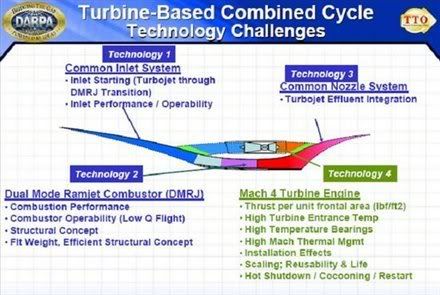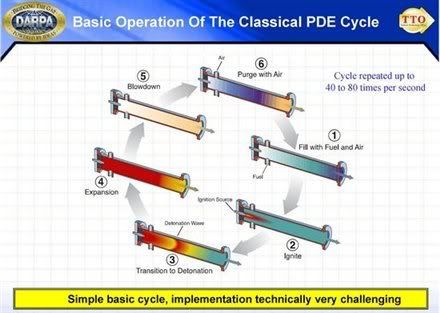Jezza
Member
DARPA Lifts the Covers on Vulcan Engine
Posted by Graham Warwick at 6/20/2008 8:58 AM CDT
If like me you are intrigued by DARPA's new Vulcan program to demonstrate a "constant volume combustion" (CVC) engine capable of powering a hypersonic vehicle from rest to Mach 4-plus, a few more details are now available at the research agency's website.
The industry day briefing begins with a review of the problem - how to accelerate a hypersonic vehicle from zero airspeed to the Mach numbers needed to fire up a supersonic-combustion ramjet. It includes a couple of interesting slides on the HTV-3X flight demonstrator conceived by Lockheed Martin's Skunk Works under DARPA's Falcon program.
 Note the size comparison between the HTV-3X, Have Blue and D-21 drone. The "vision" Hypersonic Cruise Vehicle would be SR-71-sized and has been dubbed the "SR-72" by the Skunks. The HTV-3X has given way to the Blackswift hypersonic testbed, planned to fly late in fiscal 2012, but DARPA's intent is the same - fly a reusable Mach 6+ aircraft with hydrocarbon-fuelled, turbine-based combined-cycle engines.
Note the size comparison between the HTV-3X, Have Blue and D-21 drone. The "vision" Hypersonic Cruise Vehicle would be SR-71-sized and has been dubbed the "SR-72" by the Skunks. The HTV-3X has given way to the Blackswift hypersonic testbed, planned to fly late in fiscal 2012, but DARPA's intent is the same - fly a reusable Mach 6+ aircraft with hydrocarbon-fuelled, turbine-based combined-cycle engines.
 Here's what that engine would look like - a common inlet feeding two flowpaths - one a turbojet engine that would take the vehicle from zero to Mach 4, the other a dual-mode ramjet/scramjet that would accelerate it beyond Mach 6 - and a common nozzle. This arrangement needs a high-Mach turbine engine - most turbojets can get to just above Mach 2 - and is feasible for the demonstrator because it is relatively small.
Here's what that engine would look like - a common inlet feeding two flowpaths - one a turbojet engine that would take the vehicle from zero to Mach 4, the other a dual-mode ramjet/scramjet that would accelerate it beyond Mach 6 - and a common nozzle. This arrangement needs a high-Mach turbine engine - most turbojets can get to just above Mach 2 - and is feasible for the demonstrator because it is relatively small.
But a Mach 4+ turbojet for a full-scale hypersonic vehicle would be much larger, and very expensive to develop. DARPA's idea with Vulcan is to take an unmodified Mach 2+ military turbojet - an F100, F110, F119 or F414 - and combine it with a CVC to produce a high-Mach engine that would cost much less to develop. Also, a Mach 4+ turbojet essentially works like a ramjet at high speeds and DARPA believes a CVC could be 20-30% more fuel-efficient than a ramjet.
But what is a CVC? In a conventional Brayton Cycle engine - a turbojet or a ramjet - combustion takes place at constant pressure, and volume increases. In a Humphrey Cycle engine - like a pulse-detonation engine (PDE) - combustion takes place at constant volume, and pressure increases. This results in higher thermal efficiency and lower specific fuel consumption. And here's how a PDE works...

Vulcan is the combination of a turbojet and a CVC, and DARPA says there are different ways to do that. One - called dual flowpath - has a common inlet and nozzle, but separate engines. The other - called annular - has one flowpath and the turbojet embedded inside the CVC. One challenge is that the turbine has to be cocooned above Mach 2 so it can survive the high temperatures in the Vulcan engine.
The result, according to DARPA, is a propulsion system that could go from producing 80,000 lb of turbojet thrust at zero airspeed and altitude to 50,000 lb of CVC thrust at Mach 4 and 62,500 ft. Between Mach 1.5 and Mach 2, from 20,000 ft to 35,000 ft, they will both be operating - which is another technical challenge, the agency says.
http://www.aviationweek.com/aw/blogs/defense/index.jsp?plckController=Blog&plckScript=blogScript&plckElementId=blogDest&plckBlogPage=BlogViewPost&plckPostId=Blog%3a27ec4a53-dcc8-42d0-bd3a-01329aef79a7Post%3a6adbffb4-6533-460f-b531-62f7dd64ea61
Posted by Graham Warwick at 6/20/2008 8:58 AM CDT
If like me you are intrigued by DARPA's new Vulcan program to demonstrate a "constant volume combustion" (CVC) engine capable of powering a hypersonic vehicle from rest to Mach 4-plus, a few more details are now available at the research agency's website.
The industry day briefing begins with a review of the problem - how to accelerate a hypersonic vehicle from zero airspeed to the Mach numbers needed to fire up a supersonic-combustion ramjet. It includes a couple of interesting slides on the HTV-3X flight demonstrator conceived by Lockheed Martin's Skunk Works under DARPA's Falcon program.


But a Mach 4+ turbojet for a full-scale hypersonic vehicle would be much larger, and very expensive to develop. DARPA's idea with Vulcan is to take an unmodified Mach 2+ military turbojet - an F100, F110, F119 or F414 - and combine it with a CVC to produce a high-Mach engine that would cost much less to develop. Also, a Mach 4+ turbojet essentially works like a ramjet at high speeds and DARPA believes a CVC could be 20-30% more fuel-efficient than a ramjet.
But what is a CVC? In a conventional Brayton Cycle engine - a turbojet or a ramjet - combustion takes place at constant pressure, and volume increases. In a Humphrey Cycle engine - like a pulse-detonation engine (PDE) - combustion takes place at constant volume, and pressure increases. This results in higher thermal efficiency and lower specific fuel consumption. And here's how a PDE works...

Vulcan is the combination of a turbojet and a CVC, and DARPA says there are different ways to do that. One - called dual flowpath - has a common inlet and nozzle, but separate engines. The other - called annular - has one flowpath and the turbojet embedded inside the CVC. One challenge is that the turbine has to be cocooned above Mach 2 so it can survive the high temperatures in the Vulcan engine.
The result, according to DARPA, is a propulsion system that could go from producing 80,000 lb of turbojet thrust at zero airspeed and altitude to 50,000 lb of CVC thrust at Mach 4 and 62,500 ft. Between Mach 1.5 and Mach 2, from 20,000 ft to 35,000 ft, they will both be operating - which is another technical challenge, the agency says.
http://www.aviationweek.com/aw/blogs/defense/index.jsp?plckController=Blog&plckScript=blogScript&plckElementId=blogDest&plckBlogPage=BlogViewPost&plckPostId=Blog%3a27ec4a53-dcc8-42d0-bd3a-01329aef79a7Post%3a6adbffb4-6533-460f-b531-62f7dd64ea61
